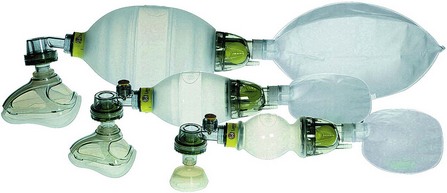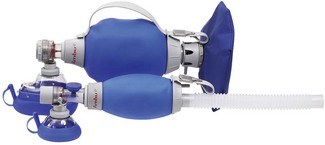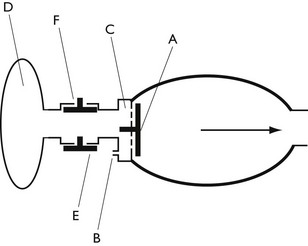Chapter 8 Manual resuscitators
Components
The self-inflating bag
This bag may be made of silicone rubber or polyvinyl chloride (PVC), which is strengthened either by making its wall thicker, or by incorporating circular ‘ribs’ of identical material during manufacture (Fig. 8.1), so that in the resting state it is expanded. Another design (Ambu Mark IV, Fig. 8.2) has an outer covering of chloroprene or butyl rubber and a thick foam inner layer, which makes the bag expand in the resting state. All devices produced now are latex-free. The PVC versions are designed to be for single use only and the others are made to be steam autoclaved.
The respirable gas inlet mechanism is housed at one end and the non-rebreathing valve at the other.
The respirable gas inlet
This inlet has a number of components (Fig. 8.3):
• A one-way flap valve (A). This is fitted to the inlet of the self-inflating bag. When the bag is squeezed, the gas pressure inside the bag rises and causes the flap valve to close. This prevents the escape of gas back through the inlet. When the bag is released, its self-inflating characteristic causes fresh gas from the respirable gas inlet to be indrawn. This may be air, oxygen or a mixture of both.
• A small bore nipple (B). This is mounted on the inlet, to allow admixture of oxygen.
• A wide bore inlet (C). This supplies the bulk of the gas entering the bag and is usually air, unless oxygen is added, as above. In the latter situation, the final concentration of oxygen delivered is a function of the amount of added oxygen and its dilution with air in the self-inflating bag.
• A reservoir system (D). The inlet (C) may be fitted with a reservoir system. This feature is now widely used in almost all manual resuscitators. Its purpose is to store the oxygen fed into the system from the nipple (B). When the minute volume of oxygen supplied is greater than the volume given to the patient, the bag (D) will expand and will provide all the gas for ventilation (i.e. 100% oxygen). The reservoir must be fitted with an overflow valve (E) to prevent overfilling from too high a flow of oxygen and an entrainment valve (F) to allow ingress of air for when oxygen is not available or when lower concentrations of oxygen are required. Tables 8.1 and 8.2
Stay updated, free articles. Join our Telegram channel

Full access? Get Clinical Tree











